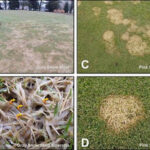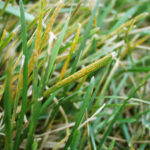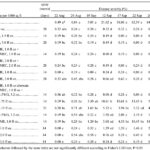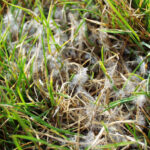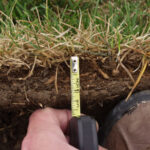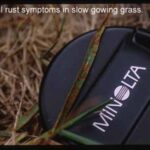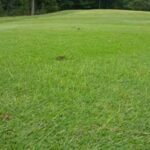Category: Disease Control
Gray Leaf Spot
Recent weather (remnants of hurricane Isaac) raised concerns about gray leaf spot in the Ohio Valley and the lower Midwest in general. You may recall that the pathogen does not overwinter efficiently in the Midwest, and inoculum (airborne spores) from storms that originate in the South is significant. Gray leaf spot is a foliar disease […]
Snow mold damage – 2011
Melting snows revealed some significant snow mold damage. As you know there are two types of snow mold diseases, gray snow mold (aka Typhula blight) and pink snow mold (Microdochium patch). Although they create similar symptoms (circular patches of tan turf—sometimes with orange/brown margins, Fig. A, C, D) the pathogens are not closely related and […]
Top Ten Turf Tips of 2010
Part II: Summer diseases in Residential Turf Part III: Summer weeds: Common summer weeds and their control Part I: Too hot: Why some turfgrass species look poor in summer Color Variation in Residential and Commercial Lawns Crabgrass Control Now is the time to seed lawns and other turf areas Choosing a Preemergence Herbicide Late Fall […]
Rust Diseases
Rust is a disease of taller mown turf. Outbreaks are most common on residential lawns, low budget athletic fields, and, occasionally, on golf course roughs. A variety of related fungi cause rust. Ccommon names include leaf rust, crown rust, and stem rust, and the disease occurs almost exclusively on Kentucky bluegrass and perennial ryegrass. Rust […]
Summer Stress
Summer Stress With a warm and wet summer, we are experiencing decline in some of our turf around the state due to temperatures, disease, insects, and weeds. In response, we are publishing a four part series on this topic to help turfgrass managers respond. Look forward to the following topics over the next two weeks. […]
Gray Leaf Spot 2010
Gray leaf spot has been identified on perennial ryegrass fairways in northern Kentucky. It is likely that outbreaks will occur in southern Indiana with the next rainstorm (or it may already be established). If the turf that you manage has a history of the disease, this would be a good time to consider apply a […]
Slime mold
Slime mold can occur on all turf grasses. The disease does not infect the plant but instead grows on the outside of the leaves. Yellowish, purplish, or grayish fruiting bodies may be observed during wet periods. As the turf begins to dry, the structures become powdery. Since the disease is only cosmetic in nature, chemical […]
Turf Disease Watch
The near term forecast indicates an early arrival of summer, when temperature and moisture conditions favor diseases that can cause serious damage to turf on golf courses, athletic fields and residential landscapes. Two of the more important diseases are discussed below. Brown Patch Brown patch is a foliar disease that does not damage crowns or […]
Snow mold damage
Melting snows revealed some significant snow mold damage. As you know there are two types of snow mold diseases, gray snow mold (aka Typhula blight) and pink snow mold (Microdochium patch). Although they create similar symptoms (circular patches of tan turf—sometimes with orange/brown margins) the pathogens are not closely related and they have different temperature requirements for infection. […]
Damping off diseases in new seedlings
Although the cool weather tends to limit disease in new seedlings, a spike in the temperatures could trigger outbreaks in juvenile turf yet this year. Late summer is clearly the best time of the year to seed for a variety of reasons, but we must deal with two difficulties of seeding at this time: Our […]
Dollar Spot
Dollar spot is caused by a fungal pathogen, Sclerotinia homoeocarpa, that blights leaf tissues but does not affect turfgrass roots or crowns. The disease is a common concern on golf course turf, especially creeping bentgrass and annual bluegrass greens, tees, and fairways, where it can result in poor turf quality and appearance. Dollar spot is one […]
Rust Diseases
Rust is a disease of taller mown turf. Outbreaks are most common on residential lawns, low budget athletic fields, and, occasionally, on golf course roughs. A variety of related fungi cause rust. Ccommon names include leaf rust, crown rust, and stem rust, and the disease occurs almost exclusively on Kentucky bluegrass and perennial ryegrass. Rust […]
Professionals only: Rust/dollar spot thriving in lawns
The diseases rust and dollar spot are thriving in Indiana lawns right now, which is fairly typical for this time of the year. These are both low nitrogen diseases, so are almost inevitable as we try to keep lawns on the lean side during the summer to minimize devastating damage from pythium, brown patch, heat […]
Patch Disease Symptoms Starting to Show in Dry Kentucky Bluegrass Lawns
Summer patch and necrotic ring spot are root-infecting diseases in Kentucky bluegrass lawns. Their symptoms are some of the most difficult to manage, much less control the disease. Although these diseases differ slightly in when they attack the roots, the pathogens generally are active in the late spring to early summer. Infection-impaired roots have a […]
Rhizoctonia Spring Patches
Brown Ring Patch Brown ring patch is a disease of annual bluegrass on putting greens. Damage is largely cosmetic, although in some areas smoothness and uniformity of putting surfaces are disturbed, warranting chemical control. The duration of symptom expression usually is brief (one or two weeks), and coincides with mild weather with ample moisture. Despite […]
Yellow Patch Is Active!
Yellow patch, also referred to as cool season brown patch, is caused by Rhizoctonia cerealis, a fungus closely related to the pathogens that cause brown patch and the Rhizoctonia large patch of zoysia grass. Although symptoms can be striking, yellow patch causes only cosmetic damage and does not affect playability. It occurs most often on creeping […]
Winterkill in warm-season turfgrasses
Winterkill in warm-season grasses is highly variable and difficult to study by scientists. Because of this, our understanding of winterkill is based on science as well as practical experience and observation. Since winterkill in warm-season grasses can be affected by genetics, temperature extremes, and management factors, an endless combination of these factors can interact to […]
Rust on the rise in turf
With the warm dry weather slowing growth of most turf areas, rust is becoming common on many non-irrigated turf areas. Rust symptoms are reddish-orange lesions or spots on the leaf blades and a rust-colored powder that you can rub off with your fingers. Rust will rarely kill a turf area further then a lawn already […]
Gray Leaf Spot Update
We have just documented the first case of gray leaf spot this year from a golf course in Bloomington . We have learned that the disease will develop over a broad range of environmental conditions (not just hot and wet) and it continues to be very dry south of Indianapolis . Our research results showed […]
Something New in Golf Course Turf…Ghost Grass and Mad Tiller Disease???
Photo by: Steve McDonald of Turfgrass Disease Solutions located in Philadelphia Photo by: Cale Bigelow in West Lafayette Over the past week a relatively new turf malady has become prevalent on golf turf throughout the region. This new phenomenon has been referred to as “Mad Tiller Disease”, and “Ghost Grass” in the United Kingdom , […]
